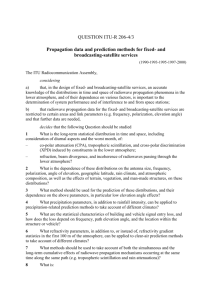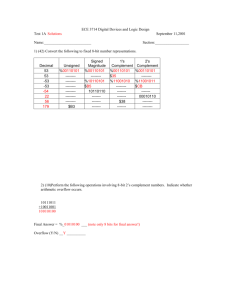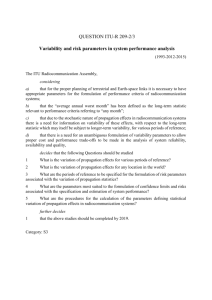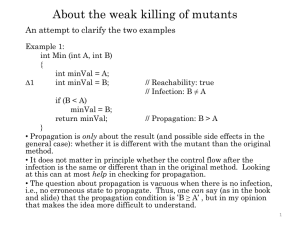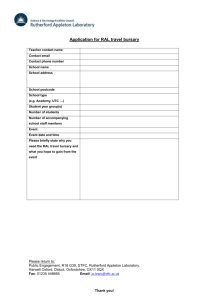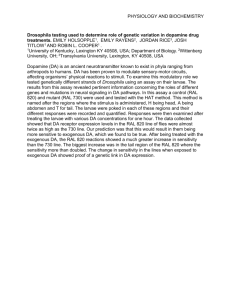Annex A: Historical Background
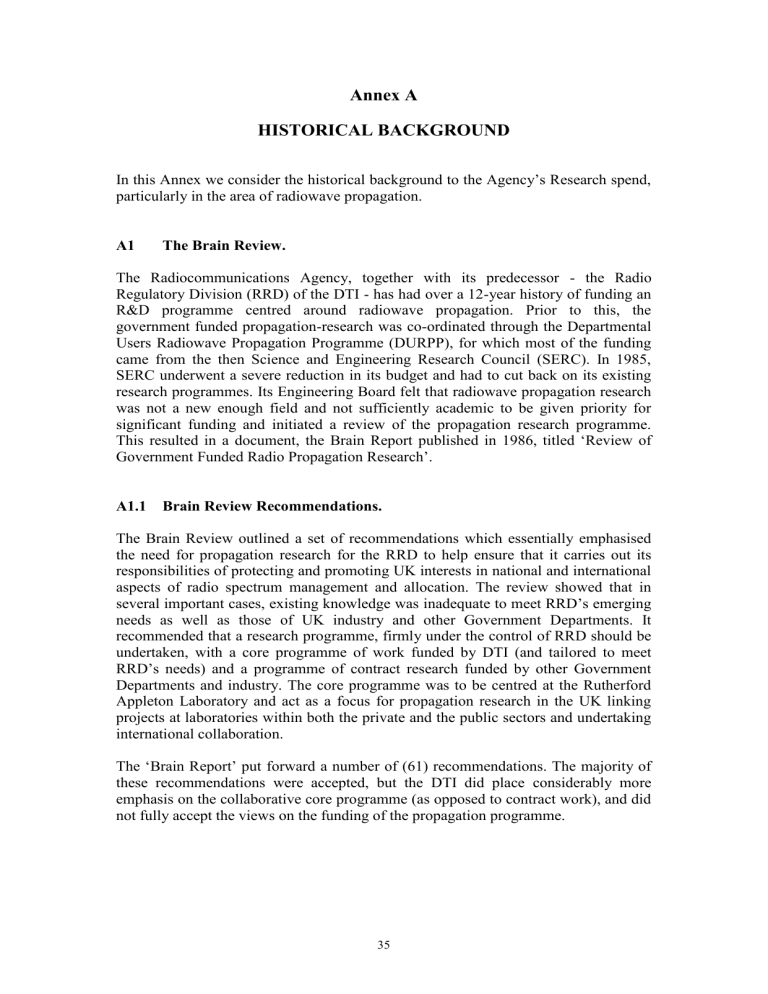
Annex A
HISTORICAL BACKGROUND
In this Annex we consider the historical background to the Agency’s Research spend, particularly in the area of radiowave propagation.
A1 The Brain Review.
The Radiocommunications Agency, together with its predecessor - the Radio
Regulatory Division (RRD) of the DTI - has had over a 12-year history of funding an
R&D programme centred around radiowave propagation. Prior to this, the government funded propagation-research was co-ordinated through the Departmental
Users Radiowave Propagation Programme (DURPP), for which most of the funding came from the then Science and Engineering Research Council (SERC). In 1985,
SERC underwent a severe reduction in its budget and had to cut back on its existing research programmes. Its Engineering Board felt that radiowave propagation research was not a new enough field and not sufficiently academic to be given priority for significant funding and initiated a review of the propagation research programme.
This resulted in a document, the Brain Report published in 1986, titled ‘Review of
Government Funded Radio Propagation Research’.
A1.1 Brain Review Recommendations.
The Brain Review outlined a set of recommendations which essentially emphasised the need for propagation research for the RRD to help ensure that it carries out its responsibilities of protecting and promoting UK interests in national and international aspects of radio spectrum management and allocation. The review showed that in several important cases, existing knowledge was inadequate to meet RRD’s emerging needs as well as those of UK industry and other Government Departments. It recommended that a research programme, firmly under the control of RRD should be undertaken, with a core programme of work funded by DTI (and tailored to meet
RRD’s needs) and a programme of contract research funded by other Government
Departments and industry. The core programme was to be centred at the Rutherford
Appleton Laboratory and act as a focus for propagation research in the UK linking projects at laboratories within both the private and the public sectors and undertaking international collaboration.
The ‘Brain Report’ put forward a number of (61) recommendations. The majority of these recommendations were accepted, but the DTI did place considerably more emphasis on the collaborative core programme (as opposed to contract work), and did not fully accept the views on the funding of the propagation programme.
35
A1.2 Implementation of the Brain Review Recommendations.
The recommendations, in accordance with the Action Plan, were accepted by
Ministers and were subsequently implemented. A new ‘National Radiowave
Propagation Committee’ (NRPC) was set up in order to provide a forum for the coordination of needs and study programmes in the field of pre-competitive radio propagation research and closely related matters. The committee was to have representatives of organisations funding the programme, with a limited number of advisers, and was to be chaired by the Agency (RA). The role of the Committee was to advise RA on the scope and content of the National Radiowave Propagation
Programme (NRPP), including its major element – the core programme of studies at the Rutherford Appleton Laboratory. The NRPP was intended to provide propagation information of value for spectrum utilisation and planning and for the design and operation of radio systems and services.
All this was implemented by the Agency and the NRPC was formed. This committee established four Technical Working Parties in the following areas:
HF propagation;
Mobile Radio;
Diffraction and Scatter;
Millimetric wave propagation .
The main purpose of these TWPs was to bring together a number of groups which were undertaking relevant studies in order to co-ordinate studies, to exchange results and to identify topics where new studies are needed. The Mobile and Diffraction
TWPs merged in 1996 and the Millimetric wave TWP was disbanded in 1998. A new
TWP was formed in the same year, concentrating on Fixed Links Outages at and above 13 GHz. The three TWPs, together with the NRPC, continue to exist to this day. The individual TWPs meet around three to six times a year and have active participation from industry, RAL, academia and a number of other governmentbodies. The NRPC meets once a year, essentially to receive reports relating to:
The core programme at RAL;
Each of the Technical Working Parties;
Relevant interests of committee members.
The NRPC also addresses issues such as NRPP funding, international matters and it’s future programme.
A2 The 1992 Review.
The NRPP was established in March 1989, with the intention of keeping – as much as possible – the propagation research in the public domain and to encourage collaborative studies, ensuring that the Agency does not duplicate studies which are undertaken elsewhere, particularly in industry. A fourth year review was initiated well in advance, in March ’92, and its report (the Withers’ Report) made available in
‘August ’92 so that its recommendations could be taken into consideration when planning financial year 1993/94, by both RA and RAL.
36
The review resulted in further recommendations, which are summarised in the following Table.
Number Recommendation Current status
1
2
Propagation research should be maintained.
Implemented / ongoing.
Expertise maintained within UK, subject to budget constraints.
Implemented / ongoing.
3
4
5
6
7
8
9
10
11
12
No decline on propagation studies. Maintained / ongoing.
Division between propagation (core) and other studies (short term contract).
Implemented / ongoing (RAL is not allowed to bid for short term
‘contract studies’.
Wide ranging propagation programme to support LMSS access techniques, e.g. CDMA, TDMA.
Some studies conducted in the past; not at RAL.
Ionospheric work for broadcasting planning and UHF non-GSO earthspace studies.
Only RAL carries out ionospheric studies.
NRPC to remain a non-executive committee.
NRPC only advises RA.
Each new project to be submitted to the Radio Research Panel (RRP).
RRP no longer exists.
RA’s main committees to comment on current research programme.
Not carried out. NRPC does not have any active industry participation.
International co-operation through
ITU-R, CEPT-ERC, COST and
URSI.
Good collaboration. RAL also actively involved in EC and ESA programmes.
NRPC to close/open new/old
Technical Working Parties (TWP).
Latest modification : TWP on mm wave propagation became more focused on Fixed Service Outages.
RA and MoD to discuss new propagation requirements.
Occasional, informal meetings.
37
13
14
15
16
RA-RAL yearly agreement. On-going.
RA to note that long-term programmes require career development/stability.
Hence RA has adopted a long-term policy, so far.
RAL to seek funds from other sources.
One third of RCRU/RAL income comes from non-RA sources.
RAL to develop opportunities for exploiting its prime assets.
Chilbolton Radar is a good example.
17 Secondment of RA staff to RAL. Never occurred.
18
A radical change in RAL propagation studies.
Not carried out.
Note: With the exception of (5), (8), (9) and (17) above, all recommendations have been (and still continue to be) implemented by RA and RAL.
A3 From 1996 to the Present.
The Agency’s Steering Board – during one of its meetings in 1996 – discussed the difficulty in determining the optimum amount of spend on research, and concluded that there should be a fundamental review of RA’s research programme. At the request of the Board, an input paper outlining the current research programme was submitted and introduced by the Agency. The Board discussed the objectives and benefits of the programme and recommended that the Agency should conduct an internal review of the research expenditure including the existing RAL programme ensuring value for money and an appropriate ‘purchaser-provider split’. The research programme was to be assessed against the objectives of:
The terms of reference for this review and the scope are given below
Terms of Reference.
“In accordance with the current RA Corporate Plan, 1997/98 to 2001/02 - item
8, the research programme will be assessed against the objectives of :
pushing back the boundaries of usable spectrum
enhancing the degree of spectrum sharing between services
providing data to help encourage industry to develop new services
securing a broader understanding and application of technical efficiency and quality criteria for spectrum management
38
Scope.
The review will help set the Agency research agenda for the foreseeable future, including R&D aspects of the spectrum efficiency scheme. The main deliverable will be a report containing a set of recommendations on how and where the Agency should spend its research funds. The review will take into account issues such as ‘value for money’, ‘purchaser-provider split’ and effective measures to audit the success of research spend
It will draw on the following:
A historical analysis of the current position and spend;
Consultation with internal Units;
External consultation (including industry, academia, some government departments, RA consultative/industry committees and bodies such as the
IEE, RSGB and Whitley council).
The review will consider whether there is a continuing need for existing work in the light of information already available, and the need to assess market dynamics and economic data.”
39


